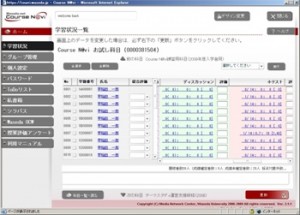01-02. Practicing More Effective Education through a Combination of On-Demand Classes and Classroom Training
Chiharu Kogo
Professor, Faculty of Human Sciences
Moving to Course N@vi was a natural progression for Professor Kogo, who specializes in education technology, which at its very core is the application of computers to education processes. He now uses many of Course N@vi’s functions, from information articles to report submissions, quizzes, grade management, and on-demand classes. We asked Professor Kogo about the future applications that such a heavy user is looking forward to.
* Interviewed in 2009.
Making on-demand content created for e-School available to campus students as well
The School of Human Sciences, to which Professor Kogo belongs, launched its Distance Learning Program (colloquially called e-School) in 2003. It is possible to graduate from e-School by taking only on-demand classes, and everything is done over the Web, including taking lectures, submitting reports, answering quizzes, and participating in discussions. With this system, then, students can obtain an education anywhere in the world where there is an Internet connection.
Partly because of this background, all classes in Professor Kogo’s three lecture courses have already packaged as on-demand content. The School of Human Sciences normally provides in-person classes as well for campus students in subjects offered by e-School. But in Professor Kogo’s case, he has been using on-demand content created for e-School with his campus students too since the 2008 academic year.
Nevertheless, Professor Kogo’s method is to combine on-demand classes with in-person classes; otherwise, if everything were done on-demand, there would be no point in having campus students. So the professor holds regular classroom classes the first week with on-demand classes the following week, and continues to alternate between the two in subsequent weeks. The 15th and final class is held in a classroom.
After taking an on-demand class, students are required to take a simple test or make a report. During the next in-class lesson the following week, the students work in small groups on practical exercises based on what they have prepared in the previous week.
Previously, each 90-minute class consisted of a 30-minute lecture followed by 60 minutes of practical exercises. There were two problems with this approach: insufficient time for practical exercises and the difficulty for students to internalize the lecture material then and there in the classroom and apply it in practical exercises.
But by having students first take an on-demand lecture, the following week the class can begin right away with the practice exercises. This approach — having students first prepare for the lesson with reports or other coursework and then running the practical exercises — has led to higher student ambition and much greater efficiency than before. “Because they work in small groups, students seem to prepare more for classes because if they don’t, it will affect the others in the group.”
During the first trial in the spring of 2008, students had to watch two video lessons every second week in order to view all 15 on-demand classes. Because of the heavy burden on the students, only eight on-demand classes were recorded for the subjects run in the fall of 2008. “Having one in-person class and one on-demand class in alternate weeks felt like the right pace for the most effective learning.”
The percentage of students obtaining credits after introducing on-demand classes has been around 80 percent, which is the same as in-person classes. Professor Kogo interprets these results to mean that “if classes reward the students’ efforts, they will devote themselves to completing the work even if it takes time and energy.” He added, “faculty members will also find that if they use Course N@vi, they can no longer get away with fluff classes anymore.”
“With this method, the number of classroom lectures is reduced to one every two weeks, which halves the labor on the teaching staff. If the teaching staff pours this extra energy into the practical exercise classes, more efficient education will be the result.” Students, too, have more energy and are more motivated in the alternate-week practical exercises compared to the weekly practical exercises held previously.
Currently, it is still rare at the School of Human Sciences to give on-demand classes to campus students. “It would be a waste at the School of Human Sciences not to use the on-demand resources we have painstakingly created. I hope to see these resources utilized more in the future.” Professor Kogo plans to use the on-demand class materials he has created for three years and then re-record new classes.
Plan to introduce on-demand classes for seminars in the 2009 academic year
Professor Kogo used a combination of on-demand classes and in-person classes for his three lecture courses in the 2008 academic year. He is planning to introduce the same methodology in his seminars as well starting in the 2009 academic year.
For example, students will first take an on-demand class with a lecture about how to select a graduation thesis topic, what topics are acceptable, or how to find references. The following week, the students meet Professor Kogo in class and carry out the assigned task. Another idea is to have each student think of three thesis topics and post these on a BBS before class. “Though I’m a little worried whether having a seminar of a dozen or so students that meets only every other week will be as successful as my lecture courses, I plan on testing various schemes and eventually figuring out a system that works.”
In the future, the professor envisions moving nearly all classes to on-demand, although some bricks-and-mortar classes will remain. “Take the University of Phoenix in the United States for example, which is a specialized online university where classes are provided completely on demand without any campus visits at all. They’ve been able to turn out very well-rounded Master’s degree graduates. The number of Japanese universities offering similar programs will probably increase over time.”
However, Western online universities do not consider streaming a number of on-demand video lectures to be a complete course; instead, they give credits only after students lead rather intense online debates. “Deep, thorough discussions like these are still lacking in Japan.”
Because Japan has never had the West’s “waging war in words” culture, Japanese students are not skilled at debating and pressing their assertions forward logically. “I think there is a lack of training in asserting oneself and persuading others.”
In addition, Professor Kogo hasn’t been impressed with the text exchanges on BBS. “Students tend to over think or have their feelings hurt easily. There are also behavioral problems, such as failing to reply promptly.” This is why he doesn’t currently use BBS as a place for debate. Instead, he has students post their opinions individually and then read and use each other’s opinions as references.
Transforming suggestions for BBS profile pictures and a chat function into reality
Professor Kogo brags that “I put in more requests for features than anyone else” while Course N@vi was in development. One of these was the review sheet function, which lets students write their impressions or questions about classes. In the first class of his lecture courses, which have around 300 students, he requires everyone to submit a review sheet as a practice and he responses with comments to every review sheet. Review sheets are optional for subsequent classes, but 20 to 30 percent of students still submit them. “It’s fantastic that I can at last understand the students’ thoughts. Some of the students’ comments could only have been written with a deep appreciation of the content of the class. I’m glad to confirm that there are serious thinkers in my classes.”
When asked about what he would like to see added to Course N@vi, he said “I’d like the screen to be more friendly, because the current screen looks bleak and unwelcoming.” For example, “If you displayed small headshots of posters on BBS, you could see what kind of person is making the post. Just that little addition would calm down the unruliness of some of the text-only exchanges.”
Another proposal of his is a chat function that would list who is currently logged in so that users could chat with people they know. “The feeling of studying together at the same time might boost their motivation. There is a definite need for chat rooms themselves so that students can talk to each other about what’s on their mind.”
As a result of suggestions by Professor Kogo and others, a BBS profile picture function is planned to be added to Course N@vi in April 2009. And adding a chat function for the 2010 academic year is under consideration.
Hopes for a mechanism that allows group work to be done online
Professor Kogo has many more dreams for Course N@vi. One of his suggestions is a group work function. “I would be delighted if they implemented a Wiki-like system. With such a system, four or five students could get together and create a single report.”
He would like to see the small group workshops he presently runs in class move online at some point. “Even though there are all kinds of tools like videoconferencing, Skype, and iChat appearing, lots of operational difficulties remain in adopting these. But it would be great in the future if we could realize the same intense sense of belonging that you get in person even though the participants are in different locations.”
“When I explain Course N@vi to new faculty members, they are very enthusiastic. If faculty members use Course N@vi from the outset, it will really make many things easy for them. I expect that as more and more staff members adopt Course N@vi, the circumstances around Course N@vi will also see big changes.”
Tips on implementing Course N@vi
“I highly recommend managing grades on Course N@vi. Not only does it make your workflow much easier, it guards against miscalculations and transcription errors.”
<Grade management window>
By entering marks for attendance, quizzes, reports, and BBS posts, the system will automatically calculate the final grades according to a preset weighting distribution.



